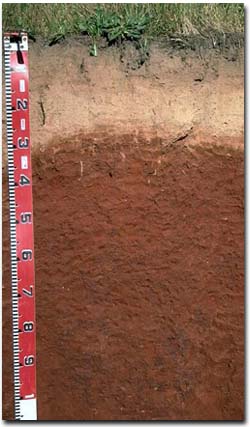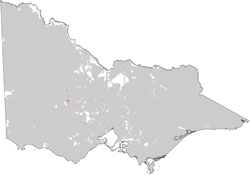Victorian Horticulture Cropping Soils - Kurosols
Back to: Victorian Horticulture Soils
| Kurosols (Australian Soil Classification) are soils that have strong texture contrast between the surface (A) horizons and the clay subsoil (B) horizons. The subsoil is strongly acid, i.e. pH is 5.4 or less in water, and non-sodic (at least in the upper horizons). |  Red Kurosol near Springhurst |
Distribution
| Kurosols are not a major horticulture cropping soil. They do, however, support viticulture in higher rainfall areas in central and north-east Victoria. In central Victoria, Kurosols occur on deeply weathered landscapes and on hills in relatively higher rainfall areas. In north-east Victoria, Red Kurosols are widespread on the lower valley slopes, fans, higher terraces and residual hills in higher rainfall areas. |  |
Management Considerations
Management strategies for all soils should include: increasing organic matter levels in the surface soil, minimising the degradation of soil aggregates and porosity, promoting the development of stable biopores, improving the calcium status of the cation exchange complex (particularly when sodium is a significant part), and breaking up any hardpans. Less frequent tillage, using less aggressive implements and working the soil at its optimum moisture content, can all assist in maintaining soil aggregation and porosity, as well as reducing organic matter breakdown.
Texture contrast soils usually have restricted root and water movement into the clay rich subsoils. The upper subsoils of Kurosols, however, are non-sodic and non-dispersive so infiltration is usually more rapid than Sodosols. Red Kurosols are better drained than their yellow and grey mottled counterparts.
The surface soil of Kurosols is often strongly acid and consequently aluminium and manganese toxicity may occur. Raising the pH level of the surface soil will help reduce that toxicity. A lime test (sampled at the paddock level) may be appropriate to determine how much lime is needed to raise pH levels. Other factors need to be considered, however, before lime is recommended (e.g. species grown, method of application, local trial responses, likely cost-benefit). Molybdenum deficiency may occur in the strongly acid surface soil and manganese toxicity can also occur, especially when waterlogged. Lime application will make molybdenum more available to plants. The upper subsoil in Kurosols is also strongly acid but more difficult to ameliorate with lime.


